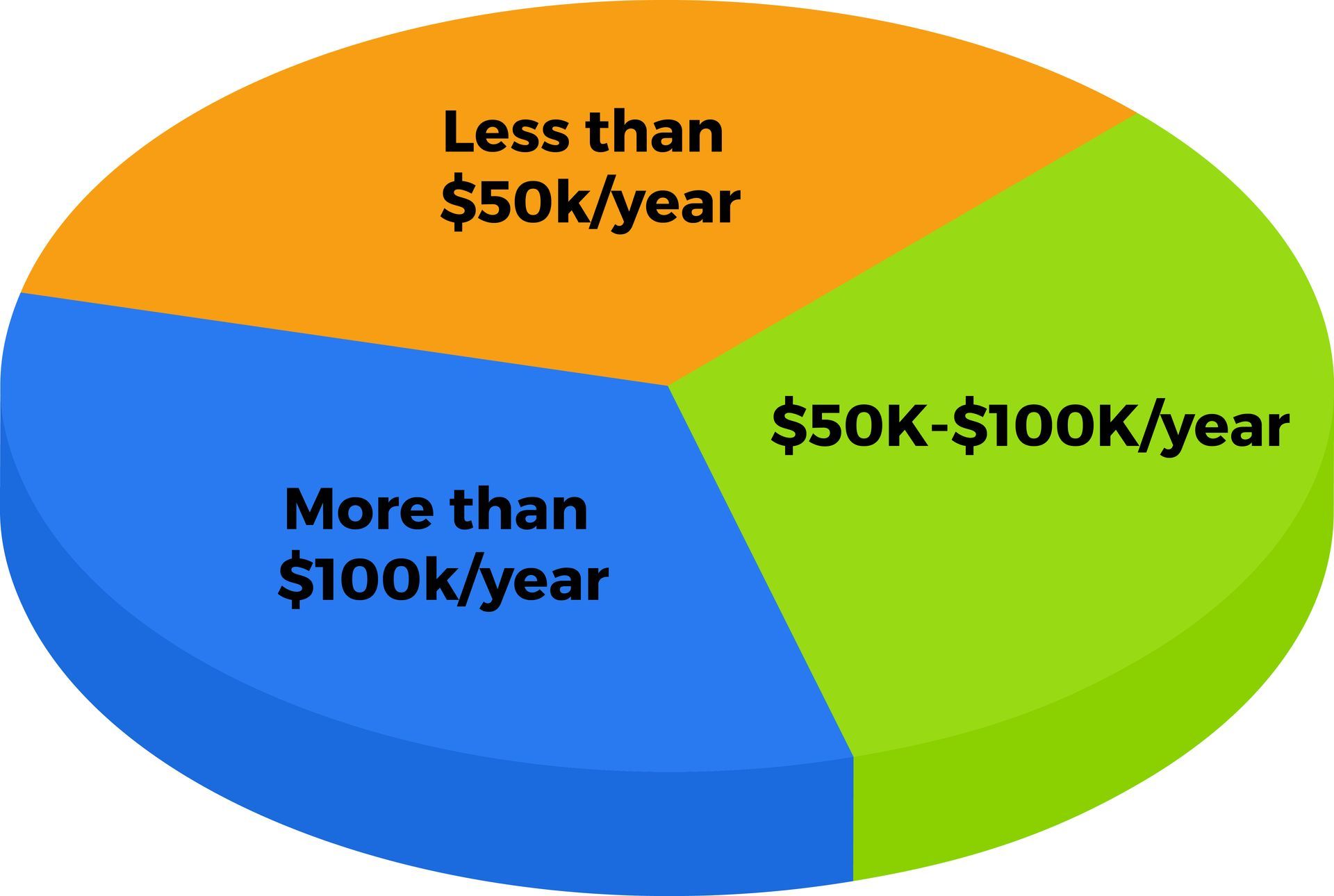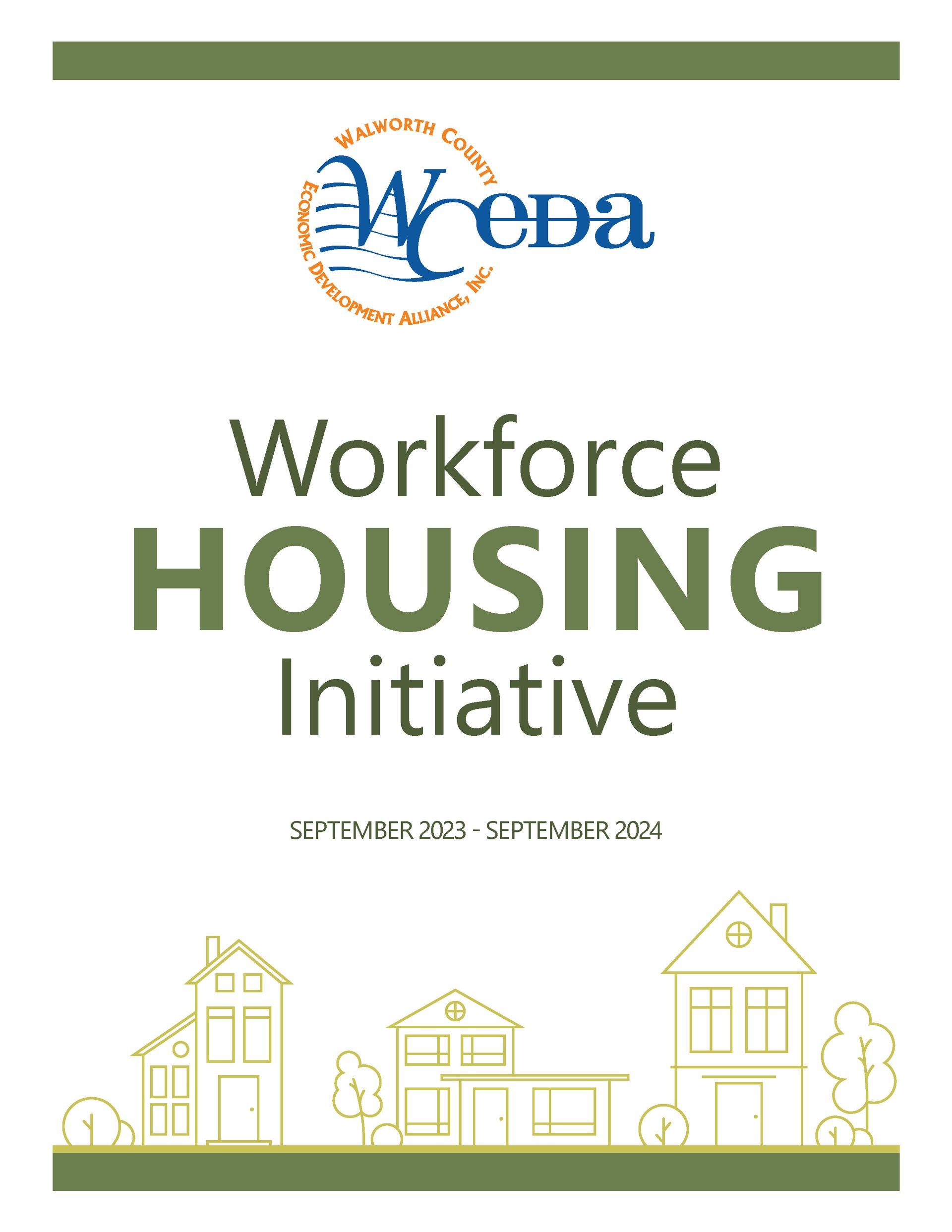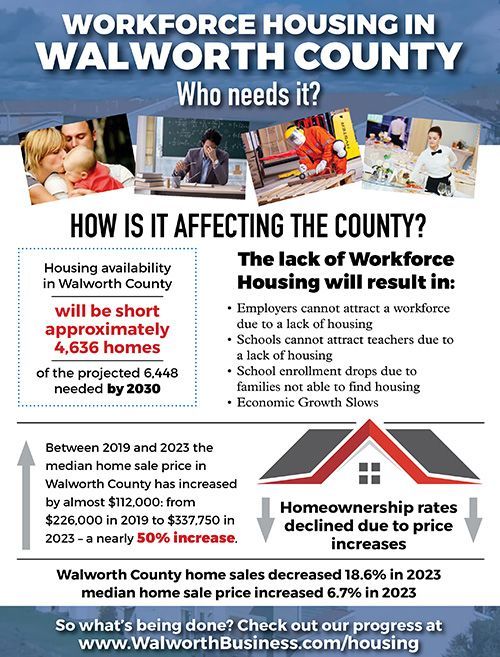Walworth County Housing Initiative

Bio
I am a graduate of Indiana University. I have worked in the non-profit sector for over 10 years in both Walworth and Rock Counties. Prior to that I worked in the housing industry in Florida. Currently I live in the beautiful city of Lake Geneva.
Municipal Housing Solutions Whitepapers
- Briefing Paper 1 - March 2024
- Briefing Paper 2 - April 2024
- Briefing Paper 3 - May 2024
- Briefing Paper 4 - June 2024
- Briefing Paper 5 - July 2024
- Briefing Paper 6 - August 2024
- Briefing Paper 7 - September 2024
- Briefing Paper 8 - October 2024
- Briefing Paper 9 - November 2024
- Briefing Paper 10 - December 2024
Lakes Area Realtors® Association
for homeowners, builders, developers and municipalities
September 2024 Newsletter Article
WCEDA Workforce Housing Initiative
September 2024 Report
about this project
Over the course of the past two years, housing has become an increasing priority for Walworth County Economic Development Alliance (WCEDA) to address. In this proposal (link to the left), you will see the evolution of WCEDA’s involvement and interest in this topic. You will also see that WCEDA’s board has determined that efforts relating to workforce housing align with its mission. Workforce housing will be spelled out in this proposal, but it is essentially what is being called the “missing middle,” and encompasses entry level workers as well as professional workers such as physicians and everything in between including public employees, like teachers, police officers, and public works staff members.
Many counties in the region are facing similar challenges and are in various stages of addressing this issue — an issue that may be the number one barrier for workforce at the moment. In Jefferson County, Green County, and Washington County (and likely many others) housing efforts are being led or co-led by economic development agencies like WCEDA.
Success for this workforce housing initiative would have some municipalities moving forward with workforce housing while others would be developing plans that would be incorporated into their comprehensive plans. This process would also yield a list of future recommendations for the county on this topic. WCEDA believes that the county has a unique opportunity to leverage ARPA dollars to make a valuable impact on workforce housing development across the county.
Far-reaching consequences
April, 2025
We've been discussing the housing shortage for quite some time now—on national, state, and local levels. But, as with many critical issues, it has slipped down the priority list in the news cycle. It's time to bring this topic back to the forefront, share the urgency of the crisis, and take meaningful action toward solutions.
Recent research paints a concerning picture: Wisconsin's housing prices have skyrocketed, ranking among the worst in the U.S. and the highest in the Midwest. While some counties have seen sharper increases than others, the overall trend is clear—housing across the state is becoming increasingly unaffordable. The root cause? Supply and demand. There simply aren’t enough homes available, making it difficult for people to live and work in Wisconsin.
Several key factors contribute to this shortage, including restrictive building codes, zoning laws, and land-use regulations. On top of that, the rising cost of building materials adds another layer of difficulty for the housing industry, further limiting supply.
The consequences of this housing crisis are far-reaching. Homeownership is becoming unattainable for many, with the median household savings sitting at just $6,100—making a traditional 20% down payment nearly impossible. As a result, the percentage of young adults living with their parents is the highest it has been since 1940. This challenge extends to the rental market as well; since 1960, the share of 25- to 35-year-olds who can afford median rent in their county has declined by an average of 7% per decade, totaling a staggering 42%+ decrease.
The ripple effects are undeniable—young individuals struggle to gain independence, working families are unable to live in the communities where they are employed, and seniors find it increasingly difficult to secure the retirement homes they’ve worked so hard for. Meanwhile, housing costs have outpaced inflation at an alarming rate. Over the past 40 years, home prices have increased fivefold, while the relative cost of housing as a percentage of household income has jumped by 65%.
The most recent data from June 2024 highlights the severity of the situation. Walworth County ranks 7th in the state for highest median home prices, with these top-ranking counties all exceeding a median price of $500,000. A closer comparison of median home prices to household incomes reveals an even more troubling statistic: Walworth County ranks 65th in affordability, confirming the lack of housing options for recent graduates, young families, first responders, medical staff, teachers, industry workers, and retirees.
To address this crisis, it will take a collective effort. The phrase "it takes a village" rings true—solving the housing shortage in Walworth County requires a collaborative approach. Stakeholders must come together to share their challenges, identify roadblocks, and implement real solutions. The Walworth County Economic Development Alliance (WCEDA) has already begun convening key players and will continue to foster partnerships aimed at expanding housing options for those who need it most.
Stay tuned for updates as we work together to tackle this pressing issue.
Where we've been and where we're going...
As we close in on the end of another calendar year it is time to take stock of what has been accomplished and what will need to be addressed in the future.
The housing shortage in Walworth County is a pressing issue with significant ripple effects on the local economy, workforce sustainability, and community well-being. Addressing this requires coordinated efforts across multiple sectors. There are key concerns and various steps of action to be considered to move forward successfully to eliminate the housing shortage.
Key Issues:
- Employment and Commuting Challenges:
◦ Over 1,400 employees commute into the county because of a lack of affordable housing.
◦ 30% of employees residing outside the county represent a missed economic opportunity, as their spending supports other regions. - Industry Impact:
◦ The county's eleven main industries—spanning manufacturing, education, trade, and hospitality—are vital to the local economy.
◦ Projected employment growth (to 41,285 average monthly jobs by 2030) heightens the urgency for accessible housing. - Economic Leakage:
◦ Workers living outside the county contribute to economic growth in neighboring areas rather than strengthening local communities.
Collaborative Progress:
- Community Assessments: Local leaders are examining the unique housing needs of their areas.
- Builder/Developer Engagement: Construction and development professionals are exploring ways to address the housing deficit.
- Financial Solutions: Lenders are beginning to identify financing options tailored to builders and prospective homeowners/renters.
- Stakeholder Involvement: Schools, industry leaders, and the public are recognizing the broader impacts of inadequate housing.
Steps Forward:
- Strategic Housing Initiatives:
◦ Look at zoning and policy frameworks to encourage affordable housing development.
◦ Incentivize mixed-use and high-density residential projects to maximize land use. - Public-Private Partnerships:
◦ Foster collaborations between government, developers, and financial institutions to share risks and resources.
◦ Secure funding through grants, low-interest loans, and tax credits for housing projects.
This multifaceted challenge requires sustained effort, but with the momentum already building in Walworth County, there’s an opportunity to turn the tide and ensure the community thrives.
Housing is Economic Development
Throughout much of the industrial 20th century, housing development served as a significant economic driver by stimulating demand for various consumer goods. The expansion of suburban housing not only increased the need for automobiles and appliances but also created substantial employment opportunities in American factories, fostering a cycle of economic growth.
Currently, however, housing affordability has reached critical levels, with over 40% of renters classified as cost-burdened—spending more than 30% of their income on housing. In approximately 80% of U.S. markets, housing prices are escalating at a rate outpacing wage growth, thereby straining moderate-income families and younger generations who struggle to manage debt and achieve stable, desirable living conditions.
The existing housing shortage is significantly hampering economic development, costing the American economy an estimated $2 trillion annually in lost wages and productivity. The lack of affordable housing constrains families' capacity to enhance their earnings, thereby contributing to slower GDP growth. Consequently, households are less able to acquire durable goods, leading to a mismatch in production and demand, while industries struggle to maintain staffing levels as they did in previous decades.
As households are unable to invest in durable goods, production rates stagnate, and industries are unable to recruit staff at previous levels. This situation exacerbates the cycle of slow economic development. Employers face challenges in attracting a competent workforce due to the scarcity of housing options. When employees cannot secure affordable housing, they may decline job offers or choose to reside outside their employment areas, diverting their spending to other regions.
Additionally, the housing crisis has implications for educational institutions, with some school districts reporting that less than 50% of their student enrollment resides within district boundaries. Teachers, too, are grappling with housing shortages; many commute significant distances, some up to 40 minutes each way, to fulfill their professional obligations.
The cumulative effects of these challenges constrain economic development. If industries fail to witness growth in their operations, workforce, and productivity, they are unlikely to contribute to overall economic expansion. Furthermore, families seeking to establish roots in their communities may relocate to regions where housing is more affordable.
Addressing the urgent need for workforce housing is critical for the future of local economic development, community vitality, and educational quality. A strategic focus on affordable housing solutions is essential to foster sustainable growth and enhance the overall well-being of residents.
Understanding the costs of developing a single family home buildable lot.
Many of the costs to develop a new housing project are more than simply the cost of the materials and labor to build the houses. These costs often are beyond any control the developer or the local municipalities would have.
To help make these developments cost effective we want to take some of the financial costs and risk out of the picture. It is important to look at creating allowable density, cooperative engineering standards and realistic municipal fees to make an already risky business venture feasible.
According to a recent Harvard University report, there are several reasons builders and
developers are unable to provide enough homes at affordable prices, including:
- high interest rates and rising inflation
- cost and availability of labor
- price of building materials
- cost and availability of developed lots
- difficulties obtaining zoning or permit approvals
Build-ready lots that do not need a major influx of funds to get them ready is one of the first and very important steps to meet the overwhelming need for housing.
Let’s look at the ways municipals can help with the development of more buildable single family home lots. If we look at three proposed developments in Wisconsin, it is obvious that the impact the municipal policies and fees have on the costs of lots in the developments is strong.
Three differences stand out and help explain why the cost of the lots differ
- allowable density (number of lots per acre)
- costs of engineering companies hired by the municipality
- infrastructure costs.
Density directly affects the project in the cost per lot in the development. In a project that is denser the cost per lot could be $16,296 where in the densest development the cost per lot could be $9,717.
Inspection fees imposed by the municipality are one of the key cost that make a difference. These fees allow the municipality to recover part of the costs communities encounter from the developer. Depending on the community, these fees could be in the higher range of $8,000 per lot, or in a lower range of $1,500 per lot. Recently a community waved their inspection fees in an agreement with the developer.
Infrastructure costs, the cost to put the water, sewer, electric, sidewalks and roads and curbs and more into a development are a major roadblock to many development efforts. If the land does not already have existing infrastructure, or is not close to already existing infrastructure allowing easy hook-up access, the cost can close down the development.
Factoring these costs into the overall cost of a development, sets the base for which the developer builds the cost of the home. So, the level at whish local policies are set can make or break the financial feasibility of new housing.
That said, it is important that both the municipality and the developer are able to participate in the development of much needed housing without either suffering in the process. Building a partnership approach to this much needed development is one way to provide the housing Wisconsin is short of.
Working together to meet the housing needs is a step at a time process leading to a favorable end.
WCEDA has been working to help facilitate the development of Workforce Housing throughout Walworth County. One question that continues to be asked is, what Is Workforce Housing?
Walworth County is short of housing for the young family, first responders, new teachers, medical staff, and multiple business staff. This workforce is made up of young professionals just starting in their careers, families wanting their children close to good schools, and those in fields such as our first responders, who are working for the safety of the residents in the county, yet not able to find housing they can afford. These individuals fall into an income category that challenges their ability to afford the current market-level prices of housing.
The 2022 Census shows that household income levels are separated into three equal (33.3%) categories:

Within these three categories, the affordable rent or home ownership prices are:
Income / Rent / Home Price (Ownership)
- $35,000 / $875 / $88,072
- $50,000 / $1,250 / $131,873
- $75,000 / $1,875 / $204,874
- $105,000 / $2,625 / $289,000
Generally, affordable housing is considered to be 30% of household income which includes mortgage or rent, utilities, and property tax. This does not factor in other financial needs of young families such as daycare.
Taking this into consideration and reflecting on the rise in housing costs the question then is, how does this group find a good home at, or close to the price they can afford?
Housing costs have risen, which has negatively impacted the production of housing. Single-family construction costs rose 37% (January 2020 to September 2023) and Multiple-family construction costs rose 38% (January 2020 – September 2023). Between 2006 and 2022 Walworth County underproduced housing units. During that period, the growth in households was 4,918, however, the development of housing units was underproduced by 4,179 units.
The movement in workforce housing is to bring together the necessary parties to address this housing shortage and get our workforce into homes.
This shortage of housing directly affects the workforce seeking housing. It also directly affects our community's growth and stability. When the new teacher can not find affordable housing close to the school, they may choose to go to another school out of the county. When the young family can not find affordable housing in the school district, they will move possibly out of the county, or out of state.
Our companies, schools, and medical community continue to share the impact of the housing shortage on their workforce and ultimately the operations of their business. The result of providing additional workforce housing in Walworth County will positively impact the residents, the schools, the medical and business communities alike. WCEDA wants to help move this forward to help build the communities in the county to be where people want to live.


